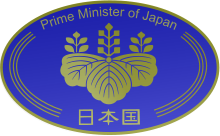Government_Seal_of_Japan
Government Seal of Japan
One of the National Seals of Japan
The Government Seal of Japan, one of the country's national seals, is the emblem (mon) of paulownia used by the Prime Minister, the Cabinet and the executive branch of the Government of Japan on official documents. It is generally known as the 5-7 Paulownia (五七桐, Go-shichi (no) Kiri), which has been used by those in power and is the official emblem of the Japanese government today. It resembles a stylized paulownia with 5-7-5 flowers. It is one of various paulownia mon, collectively known as the Paulownia Seals (桐紋, kirimon) or the Paulownia Flower Seals (桐花紋, tōkamon).[1][2]
You can help expand this article with text translated from the corresponding article in Japanese. (June 2017) Click [show] for important translation instructions.
|
